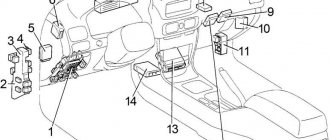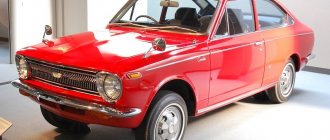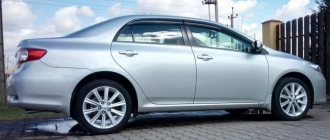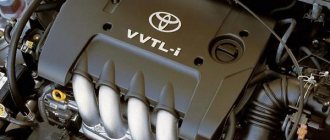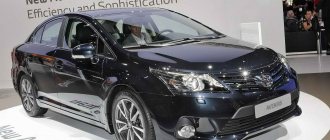Perhaps none of the Corollas has caused as much controversy as the version introduced in 1997. The front end, with large oval headlights and slightly smaller ones located side by side, was met with serious criticism. Some saw a connection with the bulging eyes of a frog, others with a disgusting huge insect. The rear lights also gave rise to ambiguous associations, but they did not irritate so much. There were so many dissatisfied statements that Toyota, after 30 months of production, modernized the car, completely revising the front end. Interestingly, this controversial experiment was limited only to the European market. On all other continents, the E11 had conventional rectangular headlights from its early days.
Despite the stylistic miscalculation, the Japanese manufacturer was pleased. The eighth generation Toyota Corolla sold just as well as its predecessor. By December 2000, 25,000,000 Corolla models had been sold worldwide. It's hard to understand what exactly was so appealing about the car, given that it was average in many respects. Neither the body design, nor the interior full of gray plastic, nor the range of engines, nor the driving performance, nor the trunk volume (hatchback: 3d - 280 l, 5d - 372 l, sedan - 390 l, station wagon - 308 l) aroused furious delight.
However, the petrol engines were quiet and economical, the multi-link rear suspension provided a high level of comfort, the relatively spacious interior gave a feeling of coziness, and the excellent workmanship was exemplary in its class.
These advantages, combined with legendary durability and reliability, apparently predicted the success of the Toyota Corolla. Today this is one of the most attractive offers on the secondary market. Especially for those who are looking for an inexpensive car that guarantees long-term operation without breakdowns. However, for this to be true, two conditions must be met: proper maintenance and high quality parts. There are no problems with the latter. You can spend a lot of money by purchasing the original, or save a little by using affordable but high-quality analogues.
Engines
Toyota Corolla gasoline engines are durable and reliable. Failures are rare. This is mainly a burnt gasket under the cylinder head or oil leakage through the crankshaft oil seal on the gearbox side. To notice leaks, you need to crawl under the car. As in many Japanese cars, corrosion overcomes the elements of the exhaust system. For example, this sometimes causes the exhaust manifold casing in the engine compartment to rattle. Experts pay attention to the problems that arise as a result of converting the engine to gas. This often leads to burnt out valves. The most reliable are petrol units with a volume of 1.3 and 1.6 liters. 1.4 and 1.6 VVT-i are slightly less durable. Especially the first one, which sometimes bothers you with increased oil consumption.
Despite high fuel prices, it is difficult to recommend the diesel engines used in Corollas between 1997 and 2000. Both 2.0 D and the later 1.9 D. The first, aspirated, was created by Toyota back in the 80s. The second, the brainchild of the French concern PSA (Peugeot, Citroen). However, old and time-tested atmospheric diesel engines do not have serious problems with durability. But they are weak and do not provide decent dynamics. If you need a diesel engine, then it’s better to take a closer look at the 90-horsepower 2.0 D-4D, which has been used since the fall of 2000. The engine is characterized by turbocharging, a common rail injection system, quiet operation and dynamics. However, finding such a version will be very difficult.
Modifications of popular cars
The Corolla sales center was first called Toyota Public Store in Japan. Toyota Publica cars were offered to customers here. The Corolla car began to be sold almost at the same time as the rebadged Sprinter brand. Over the years, there have been high-quality additions: the twins Sprinter Marino and Corolla Ceres (hardtop), sports versions of the Sprinter Trueno and Corolla Levin.
Toyota Corolla FX GT
Under the Toyota brand, the Corolla FX with a hatchback body was released. This brand later became known as Corolla RunX. Then the Corolla ZZE128 appeared on the market. The Corolla Verso minivan was originally intended for the European market. This model has a variant for Japan - Corolla Spacio, the production of which has been suspended since the tenth generation.
A variation of the Corolla, Rumion, is known in America as the Scion xB. North American marketers launched the Toyota Corolla Matrix on the E140 and E120 platforms. Toyota Australia produced the Corolla TE72 station wagon. In Australia, the five-door station wagon was sold on the automotive market as the Corolla Seca. The name has traditionally been transferred to new generations of five-door models.
Toyota's first model with front-wheel drive was the Corolla Tercel, which rolled off the factory assembly line in 1980. After some time, the Corolla II with a hatchback body appeared on the Tercel base. The service life of the Toyota Corolla engine ensured good speed, reliability and a long period of operation.
Body
Toyota Corolla is very well protected from corrosion. Oval headlights are a real nightmare for Corolla owners: the seals come apart. Do-it-yourself repairs are usually not as effective. The problem disappeared along with the oval headlights at the end of 1999 - during a deep facelift. Not all copies were equipped with central locking. Those installed in workshops are unreliable, unlike the original ones, which are practically trouble-free.
E20, second generation
Toyota Corolla body E20
In 1970, in May, the first version of the E20 appeared, the second generation Corolla with a wheelbase of 91.9 inches. The body of this model has become more streamlined, the dimensions have increased slightly. Unlike the first generation, this version was presented to customers in two versions. The engine capacity of one of them, the OHV-1400T, was 1.4 liters with a power of ninety horsepower. The volume of another engine, OHV-1600 2T, is 1.6 liters, and the power is first one hundred and two horsepower, later increased to one hundred and fifteen horsepower. Accordingly, the cost also differed. From this year, the production of Sprinter and Corolla was already distinguished by finishing and metal processing methods. In March 1972, an improved version of the Corolla Levin appeared, equipped with a 2T engine with 2 camshafts. There were no changes to the suspension; the lights, radiator grille, turn signals and headlights were different. Body corrosion protection turned out to be at a low level, so sales decreased.
In Australia, the second generation was presented by the KE20 station wagon, equipped with a 3K engine, and a two-door sedan. These models had a single brake system with drums at the rear and brake pads at the front. In New Zealand, the KE20 model, a four-door Corolla, appeared on the car market.
Model history
1997, May - premiere of the eighth generation Toyota Corolla - factory index E11. Body: 3 and 5 door hatchback, 4 door sedan and 5 door station wagon. Engines: 16-valve petrol 1.3 l 86 hp, 1.6 l 110 hp, 1.8 l 110 hp and diesel 2.0D 72 hp.
1999, spring - sports version of the G6 with a 1.6 liter engine and a six-speed gearbox.
1999, December - body update, new block headlights (double headlights with separate high and low beams). New 16-valve petrol engines with variable valve timing system: 1.4 l VVT-i 97 hp, 1.6 l VVT-i 110 hp. and a new diesel 1.9D 69 hp. 1.3L and 1.6L engines excluded.
2000, autumn - new 2.0 D-4D turbodiesel engine with a Common Rail injection system with a power of 90 hp.
2001, autumn - premiere of the next, ninth generation Corolla.
About Toyota Corolla engines 8th generation E110 (1995 - 2002)
Toyota Corolla, a very popular golf car. This car was listed in the Guinness Book of Records as the best-selling model in the world. And each of us can easily verify the validity of this statement by simply assessing how often Toyota Corolla is found on our roads. Of course, many different engine options were installed on the car. In this article we will look at the eighth generation of E110 engines.
TOYOTA 5A-F ENGINE
The Toyota 5A engine is an analogue of the 4A unit, with a reduced cylinder diameter to obtain a volume of 1500 cc. In general, this is the same 4A-F/FE/FHE, with advantages and disadvantages.
There are no sports engine options and it is a regular civilian engine. However, there are several other modifications.
- 5A-F, a variation of the carburetor type, which is a smaller volume analogue of the 4A-F. The engine was produced in 1987-1990.
- 5A-FE, similar to 4A-FE, is essentially a 5A-F with electronic fuel injection. It has a compression ratio of 9.6 and a power of 105 hp. The engine was produced in 1987-2006.
- 5A-FHE, a modification of which the cylinder head was modified, different camshafts were installed, the intake was slightly changed, and the intake manifold was changed. The engine had a power of 120 hp. and was produced in 19891-1999.
Among the weaknesses of the engine, problems with the distributor and lambda probe are noted. Malfunctions of the engine temperature sensor are typical. In this case, the engine stops starting and the speed begins to fluctuate. The engine does not have hydraulic compensators, so it is necessary to adjust the valves.
TUNING OPPORTUNITIES
Chip tuning and atmospheric tuning will not give much results. You can try, but the effect will be insignificant. You can try installing a turbine; according to reviews, this allows you to get 140-150 hp, but this will greatly affect the resource.
TOYOTA 4A-C ENGINE
Along with the well-known and popular engines of the S line, the smaller 4A line was released and is precisely a representative of such engines. Initially, it was a single-shaft carburetor low-power engine, which was nothing special. Over time, the engine was refined, the 4A had 16 and then 20 valves, evil camshafts, they experimented with the intake system and piston. A number of variations were equipped with mechanical superchargers. In total, the engine had about ten modifications.
Among the malfunctions the following are noted.
- High fuel consumption. The reason is most often the lambda probe, so it should be replaced. If there is soot on the spark plugs, black smoke appears from the exhaust pipe, the engine vibrates at idle, in this case it is necessary to check the absolute pressure sensor.
- If the engine vibrates and an unnatural amount of fuel is consumed, you need to wash the injectors.
- There are problems with speed. It is necessary to check the idle air valve and clean the throttle valve.
- If the engine stops starting, the speed fluctuates, you need to check the engine temperature sensor.
- The engine may stall. Checking the fuel filter, fuel pump, and distributor will help.
- The engine may knock. Perhaps the problem is in the piston pins or valves. In addition, the engine is characterized by problems with crankshaft seals and ignition.
TUNING OPPORTUNITIES
The engine is well suited for chip tuning and atmospheric tuning. As a result of this modification, you can get 140-150 hp. If you want more, you will need to install a turbine, which will allow you to get over 400 hp.
TOYOTA 7A-FE ENGINE
The Toyota 7A engine is another variation based on the basic 4A unit, with a crankshaft with an increased stroke and a higher cylinder block height. Otherwise they are similar. The 7A-FE did not have a lot of modifications, and in accordance with the settings, it developed power from 105 hp. up to 120 hp
The engine has a number of problems with the distributor and sensors. It is characterized by knocking noises caused by the piston pins. Due to the fact that they are not adjusted, the valves knock.
TUNING OPPORTUNITIES
In terms of atmospheric tuning, it is difficult to achieve any impressive results. You can try the option with a turbine, only this will allow you to achieve at least some effect.
| Engine | Toyota 5A-F | Toyota 4A-C | Toyota 7A-FE |
| Engine make | 5A | 4A | 7A |
| Years of manufacture | 1987-present | 1982-2002 | 1990-2002 |
| Cylinder block material | cast iron | cast iron | cast iron |
| Supply system | carburetor/injector | carburetor/injector | injector |
| Type | in-line | in-line | in-line |
| Number of cylinders | 4 | 4 | 4 |
| Valves per cylinder | 4 | 4/2/5 | 4 |
| Piston stroke, mm | 77 | 77 | 85.5 |
| Cylinder diameter, mm | 78.7 | 81 | 81 |
| Compression ratio | 9.8 | 8 8.9 9 9.3 9.4 9.5 10.3 10.5 11 | 9.5 |
| Engine capacity, cc | 1498 | 1587 | 1762 |
| Engine power, hp/rpm | 85/6000 100/5600 105/6000 120/6000 | 78/5600 84/5600 90/4800 95/6000 100/5600 105/6000 110/6000 112/6600 115/5800 125/7200 128/7200 145/6400 160/7400 165/7600 170/6400 | 105/5200 110/5600 115/5600 120/6000 |
| Torque, Nm/rpm | 122/3600 138/4400 131/4800 132/4800 | 117/2800 130/3600 130/3600 135/3600 136/3600 142/3200 142/4800 131/4800 145/4800 149/4800 149/4800 190/4400 162/5200 162/5600 206/4400 | 159/2800 156/2800 149/2800 157/4400 |
| Fuel | 92 | 92-95 | 92 |
| Environmental standards | — | — | — |
| Engine weight, kg | — | 154 | — |
| Fuel consumption, l/100 km - city - highway - mixed. | 6.8 4.0 5.0 | 10.5 7.9 9.0 | 7.2 4.2 5.3 |
| Oil consumption, g/1000 km | up to 1000 | up to 1000 | up to 1000 |
| Engine oil | 5W-30 10W-30 15W-40 20W-50 | 5W-30 10W-30 15W-40 20W-50 | 5W-30 10W-30 15W-40 20W-50 |
| How much oil is in the engine | 3.5 | 3.9 | 4.7 |
| Oil change carried out, km | 10000 (better 5000) | 10000 (better 5000) | 10000 (better 5000) |
| Engine operating temperature, degrees. | — | — | — |
| Engine life, thousand km - according to the plant - in practice | n.d. 300+ | 300 300+ | n.d. 300+ |
| Tuning - potential - without loss of resource | n.d. n.d. | 300+ n.a. | n.d. n.d. |
| The engine was installed | Toyota Corolla Toyota Corona Toyota Carina Toyota Corolla Ceres Toyota G Touring Toyota Sprinter Toyota Sprinter Marino Toyota Tercel Toyota Vios FAW Xiali Weizhi | Toyota Corolla Toyota Corona Toyota Carina Toyota Carina E Toyota Celica Toyota Avensis Toyota Caldina Toyota AE86 Toyota MR2 Toyota Corolla Ceres Toyota Corolla Levin Toyota Corolla Spacio Toyota Sprinter Toyota Sprinter Carib Toyota Sprinter Marino Toyota Sprinter Trueno Elfin Type 3 Clubman Chevrolet Nova Geo Prizm | Toyota Corolla Toyota Corona Toyota Carina Toyota Carina E Toyota Avensis Toyota Caldina Toyota Celica Toyota Corolla Spacio Toyota Sprinter Carib Geo Prizm |
VIN number
The plate and VIN are located in the engine compartment on the partition separating the interior. On the left is a plate, on the right is an identification number.
VIN decoding:
Position 1-3 – world manufacturer code: JT1 – Toyota, Japan; SB-1 – Toyota, UK.
Position 4-5 – body type: 52 – 3-door hatchback, 53 – 4-door sedan, 54 – 5-door hatchback, 72 – 5-door station wagon.
Position 6 – engine type: E – 1.3 16V; A - 1.6 16V; C - 1.4 16V VVT-i, 1.6 16V VVT-i; C - 2.0 D, 2.0 16V D4-D.
Position 7 - model code: E - Corolla.
Position 8-9 – generation: B1 – E11, 1997 – 2001
Position 10 – unused characters, “0” is entered.
Position 11 – place of production: 0.3 – Japan, E – Great Britain.
Position 12-17 – serial number.
E30, E40, E50, E60, third generation
Toyota Corolla E30 body
The debut of the third generation in April 1974 coincided with the oil crisis. Demand for the Corolla, especially in the United States, began to grow as it was a practical and economical model. For the first time in the history of the family, the company has become a leader in terms of production volume of these machines.
The body indexes of cars sold in different countries differed significantly:
- in Japan - E30, 35, 36, 37, 50, 51, 52, 53;
- in Europe – E30;
- in the USA - E31, 37, 38, 51;
- in Australia - KE30, 35, 38, 55.
The E51 and E50 indices were used for brands with a liftback body, while the E60 and E40 indices were used to sell the Toyota Sprinter. The most affordable modification of all is a two-door sedan equipped with a 3K engine, which had a volume of 1.2 liters with a power of fifty-five horsepower and a standard manual transmission-4. The rear suspension has undergone changes, springs have appeared instead of springs. Engine power was reduced due to the installation of a catalytic converter.
The most common engines of 1.2 and 1.6 liters produced power of 55 and 75 horsepower, respectively. In a number of countries there was a 1.3-liter engine with a power of 60 hp. The 2T-G engine (1.6 l, 124 hp) was sold in Japan. The body remained unstable to corrosion. A little later, four-door sedans appeared on the market.
E80, fifth generation
Toyota Corolla E80 body
The presentation of the fifth generation took place in May 1983. Five-door hatchbacks and sedans appeared on the market. In 1984, another five-door hatchback was created for the European market. The engines remained the same, as did the manual gearbox-5. The automatic transmission could have not only four, but also three steps.
For the first time they began selling cars with a diesel engine (1.8 liters, 58 hp). They made the rear wheel suspension independent. The drive became front-wheel drive. For the first time on a Corolla, the engine was placed transversely. The sports models used a 1.6-liter 4A-GE engine with a power of up to 130 hp. With. The station wagon with all-wheel drive was sold only in the USA.


